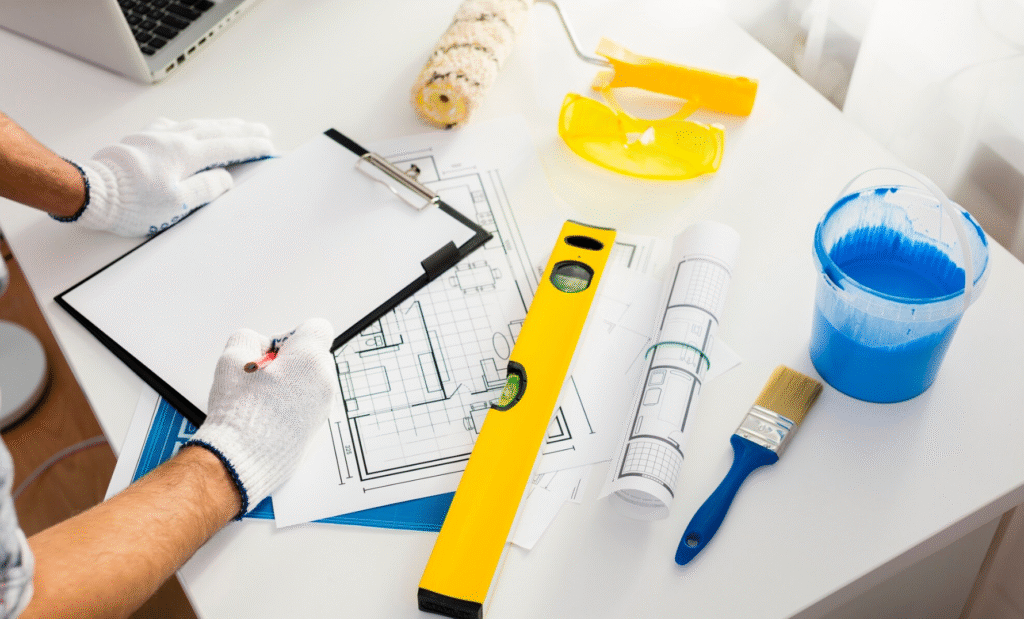Home renovations can feel overwhelming—especially when you’re trying to pin down a realistic cost before the dust even settles. Whether you’re planning to redo a kitchen, upgrade bathrooms, or reimagine your entire home layout, knowing where to start with estimating is critical.
This guide walks you through how to approach residential remodel estimating with confidence, whether you’re a homeowner or contractor offering residential estimating services.
Identifying the Scope of Your Remodel
Before crunching any numbers, it’s essential to define what you’re remodeling.
Full Renovation vs. Partial Remodel
- Full Remodel: Involves structural changes, layout reconfigurations, and usually requires permits.
- Partial Remodel: Smaller upgrades like replacing cabinets, flooring, or fixtures.
The scope determines everything, from labor time to the permits required, so clarify this early.
1) Guessing the Cost Without a Plan
Why Ballpark Estimates Can Mislead
Jumping into cost estimating without architectural drawings or at least a written scope often leads to unrealistic budgeting.
Create a Basic Scope of Work
Here’s what to include in a simple outline:
- Room(s) being remodeled
- Demolition needs
- Structural or layout changes
- Fixture/appliance updates
- Electrical or plumbing adjustments
- Surface finishes (flooring, tile, paint)
Even a rough sketch paired with this list helps professionals offering residential estimating services create a more accurate takeoff.
2) Underestimating Costs by Trade
Break Down Costs by Category
When you’re estimating, it’s better to split costs by major trade areas. Here’s a basic breakdown to get started:
| Category | Average Cost Range per Sq Ft (U.S.) |
| Demolition | $2 – $7 |
| Framing | $7 – $16 |
| Electrical | $8 – $15 |
| Plumbing | $6 – $12 |
| HVAC | $4 – $10 |
| Drywall & Insulation | $4 – $10 |
| Finish Carpentry | $10 – $20 |
| Flooring | $6 – $12 |
| Painting | $3 – $7 |
Source: HomeAdvisor 2024 Remodel Cost Guide
Material Price Volatility
Due to ongoing supply chain challenges and inflation trends, material prices are subject to change. Always check with local suppliers and factor in a 10–15% contingency.
3) Ignoring Permits and Compliance
Don’t Skip Building Codes or Local Regulations
Even for cosmetic updates, you may need a permit, especially when plumbing or electrical systems are involved.
Who Handles Permits?
- Homeowners: Can apply for permits themselves but must ensure work meets code.
- Contractors: Typically handle the paperwork as part of their residential estimating services.
Permit fees vary by city and scope but range from $100 to $2,000 on average.
4) Using Online Calculators Blindly
Estimating Tools Can Help, but Use with Caution
There are plenty of online remodeling calculators, but many assume national averages and ignore regional cost differences. Use them for ballpark figures, not final budgets.
Instead, consider hiring an independent residential estimator or using professional residential estimating services that factor in:
- Local labor rates
- Zoning codes
- Site conditions
- Lead times on materials
Building a Realistic Remodel Estimate
Here’s a checklist of what you or your estimator should include:
Components of a Full Estimate
- Labor Hours & Rates
- Material Quantities and Costs
- Permit & Inspection Fees
- Subcontractor Bids
- Overhead and Profit Margin
- Contingency Budget (10–15%)
Sample Remodel Cost by Project Type
| Remodel Type | Average U.S. Cost Range |
| Kitchen Remodel | $15,000 – $60,000 |
| Bathroom Remodel | $6,000 – $20,000 |
| Whole Home Renovation | $50,000 – $200,000+ |
Source: Remodeling Magazine Cost vs. Value Report 2024
4) Forgetting Contingencies and Schedule Buffers
Always Budget for the Unexpected
- Unseen structural issues
- Delays in material delivery
- Change orders from design revisions
A good rule of thumb is to add 15–20% of the total budget for surprises.
When to Bring in a Residential Estimating Professional
If you’re handling a remodel early in the planning process can:
- Prevent costly underbids
- Avoid missed items like permits or lead-safe practices
- Provide you with professional takeoffs and trade-specific details
These services also help contractors win bids with confidence and give homeowners peace of mind that they’re financially prepared.
Final Thoughts
Whether you’re a homeowner diving into a dream remodel or a contractor preparing a winning proposal, residential remodel estimating starts with clarity. Break down each component, use real data, and never underestimate the value of professional residential estimating services.







